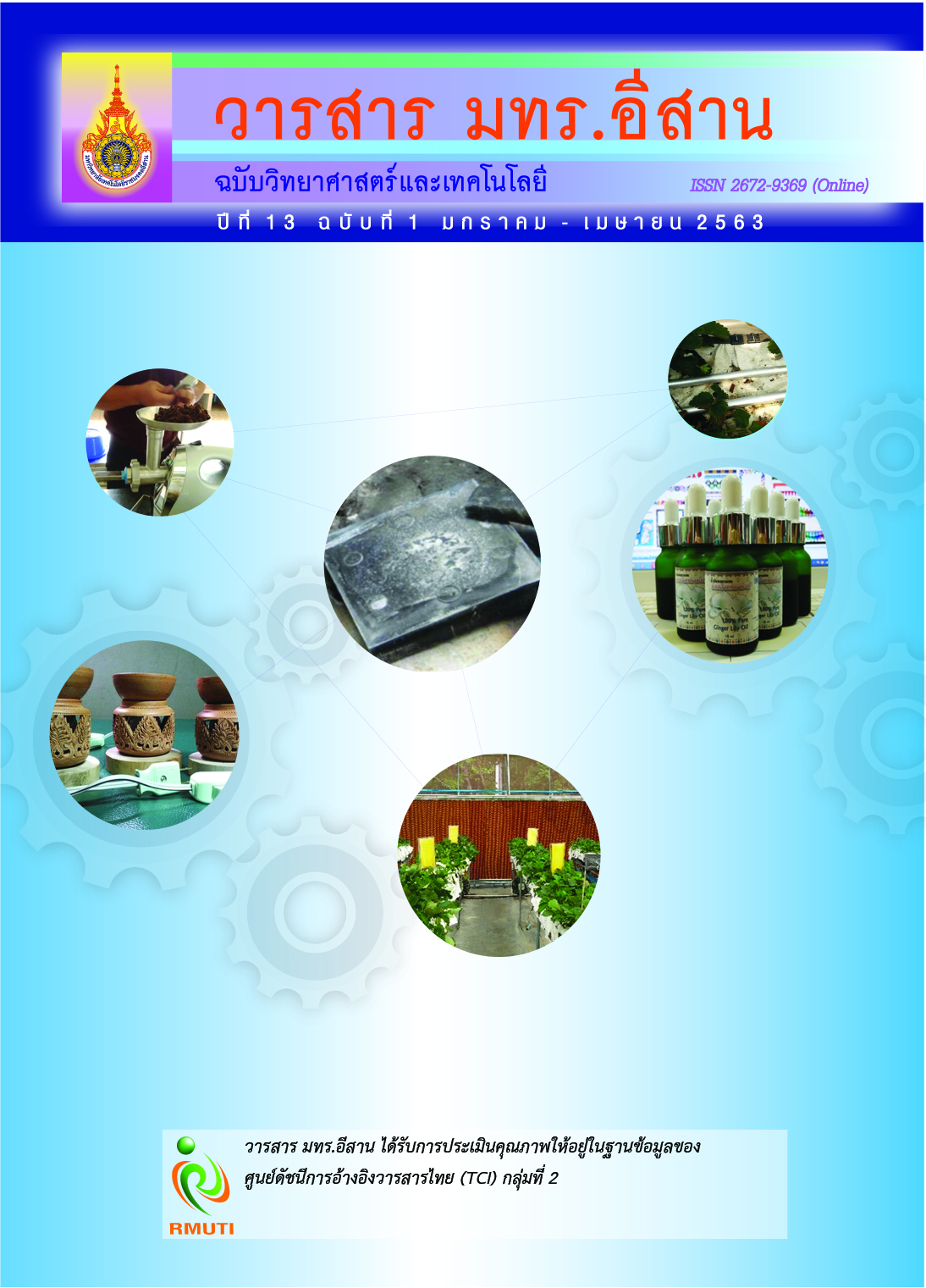ผลกระทบของความชื้นของวัสดุต่อประสิทธิภาพของการสำรวจด้วยคลื่นเรดาห์
Main Article Content
บทคัดย่อ
ประสิทธิภาพการสำรวจด้วยคลื่นเรดาห์ (Ground Penetration Radar; GPR) ขึ้นอยู่กับความเข้มของสัญญาณสะท้อนของคลื่นที่วัดได้จากความสูงยอดคลื่น (Amplitude) ขึ้นอยู่กับเงื่อนไขของสภาพแวดล้อม โดยความชื้นในวัสดุเป็นผลกระทบหลักต่อการสะท้อนของคลื่นซึ่งก่อให้เกิดการลดทอนสัญญาณ (Attenuation) งานวิจัยนี้ได้ศึกษาผลของความชื้นในผิวทางแอสฟัลต์ติกคอนกรีตและพื้นทางซีเมนต์ (Cement-Treated Base; CTB) ที่มีผลต่อสัญญาณคลื่นเรดาห์ในการตรวจพบระดับน้ำใต้ดิน โดยทำการทดสอบในห้องปฏิบัติการเพื่อหาค่าคงที่ไดอิเล็กตริก (Dielectric Constant; ) ด้วยการวัดระยะเวลาไป - กลับ ของคลื่นผ่านตัวอย่างที่ได้จากภาคสนาม ผลที่ได้จากการทดสอบถูกใช้ในการแปลงระยะเวลาไป - กลับ ของคลื่นให้เป็นระยะความลึกและเพื่ออธิบายผลเนื่องจากแรงตึงผิวที่เกิดขึ้นในชั้นวัสดุที่ทำให้ไม่สามารถระบุตำแหน่งของระดับน้ำใต้ดินได้ในผลการสำรวจ ตัวอย่างพื้นทางซีเมนต์ได้ถูกทำการทดสอบเพื่อหาการยกตัวของนํ้าเนื่องจากแรงตึงผิวในห้องปฏิบัติการ นอกจากนั้นยังได้ทำการศึกษาผลการสะท้อนคลื่นเนื่องจากแรงตึงผิวด้วยการจำลองผลคลื่นเพื่อตรวจทานผลการสำรวจที่ได้จากภาคสนามและห้องปฏิบัติการ ผลการศึกษาพบว่าค่าคงที่ไดอิเล็กตริกเฉลี่ยจากตัวอย่างแห้งและตัวอย่างเปียก คือ 7 และ 20 ตามลำดับ ผลการทดสอบแรงตึงผิวของนํ้าในแท่งตัวอย่างพื้นทางคอนกรีตแห้ง พบว่าระดับความสูงที่เกิดขึ้น เนื่องจากแรงตึงผิวของนํ้าในช่วงเวลา 24 ชม. มีค่าเท่ากับ 4.3 ซม. การจำลองผลคลื่นพบว่ายอดคลื่นที่เกิดการสะท้อนผ่านชั้นวัสดุที่เกิดแรงตึงผิวมีความสูงลดลง
Article Details
เอกสารอ้างอิง
Carl, L., Pannir, K., Kenji, Y., Steve, A., and Prasad, G. (2003). Design and Field Experiments of a Ground‐Penetrating Radar for Mars Exploration. Journal of Geophysical Research. Vol. 108, Issue E4, pp. 15-1 to 15-12. DOI: 10.1029/2003JE002113
Liu, L. B., Qian, R. Y., Li, J., Sun, M. G., and Ge, S. C. (2016). GPR Detection of Subsurface Voids and Its Validation Based on Similarity Principle. In 16th International Conference on Ground Penetrating Radar (GPR). Hong Kong, 2016, pp. 1-4
Gary, K. (1998). Effect of Soil Moisture on Radar Detection of Simulant Mines. Fact Sheet. Access (25 July 2018). Available (https://uxoinfo.com/blogcfc/client/enclosures/CRREL26.pdf)
Topp, G. C., Davis, J. L., and Annan, A. P. (1980). Electromagnetic Determination of Soil Water Content Measurement in Coaxial Transmission Line. Water Resources Research. Vol. 16, Issue 3, pp. 574-582. DOI: 10.1029/WR016i003p00574
Giao P. H., Vichalai, C., and Hien, D. H. (2007). A Study on Geotechnical and Geophysical Properties of Styrofoam Material for Construction of a Concrete Pavement Model, Proc. Intl’Symp. Hanoi Geoengineering 2007, November 2007, Hanoi, Vietnam, pp. 11-17
Von Hippel AR (ed). (1954). Dielectric Materials and Applications. MIT Press, Cambridge MA, USA
Davis, J. L., Annan, A. P. (1989). Ground Penetrating Radar for High-Resolution Mapping of Soil and Rock Stratigraphy. Geophysics Prospecting Journal. Vol. 37, Issue 5, pp. 531-551. DOI: 10.1111/j.1365-2478.1989.tb02221.x
Hoekstra, P. and Delaney, A. (1974). Dielectric Properties of Soils at UHF and Microwave Frequencies. Journal of Geophysical Research. Vol. 79, Issue 11, pp. 1699-1708. DOI: 10.1029/JB079i011p01699
Arthur R. von Hippel. (1954). Dielectrics and Waves. MIT Press, Cambridge MA, USA. p. 537
Kirsch, R. (2006). Ground Penetration Radar (GPR). In Groundwater Geophysics : A Tool for Hydrology. Second Edition, Springer. p. 232
Baker-Jarvis, J., Janezic, M. D., and DeGroot, D. C. (2010). High-Frequency Dielectric Measurements, Part 24 in a Series of Tutorials on Instrumentation and Measurement. IEEE Instrumentation & Measurement Magazine. pp. 24-31
Yaw, K. C. (2012). Measurement of Dielectric Material Properties Application Note. Rhode and Shawrtz Technical Publication
ASTM D4748-10. (2015). Standard Test Method for Determining Thickness of Bound Pavement Layers using Short-Pulse Radar. Annual Book of ASTM Standards 2002, Section 04: Construction Soil and Rock (I). American Society for Testing and Materials. Vol. 04.08.
Asian Institute of Technology (2009). An Investigation of Shallow Groundwater Conditions in the CTB Layer at the Suvarnabhumi International Airport. Final report. School of Engineering and Technology, Bangkok, Thailand.
Geoscanner, A. B. (2006). GPRSim.net. Access (27 July 2018). Available (www.geoscanners.com)
Antonis, G. (2006). GprMaxV2.0. Access (27 July 2018). Available (www.gprmax.org)
Shang, J. Q., Umana, J. A., Bartlett, F. M., and Rossiter, J. R. (1999). Measurement of Complex Permittivity of Asphalt Pavement Materials. Journal of Transportation Engineering. Vol. 125, Issue 4, pp. 347-356
Gomes, A. M. (2003). Permeability of Concrete: A Study Intended for the “in situ” Valuation Using Portable Instruments and Traditional Techniques. In Proceeding of International Symposium on Non-Destructive Testing in Civil Engineering (NDT-CE). September 16-19, in Berlin, Germany
Brama, M. D. and Khaled, S. (2014). Capillary Force in the Soil. In Principles of Geotechnical Engineering. eight edition. USA


